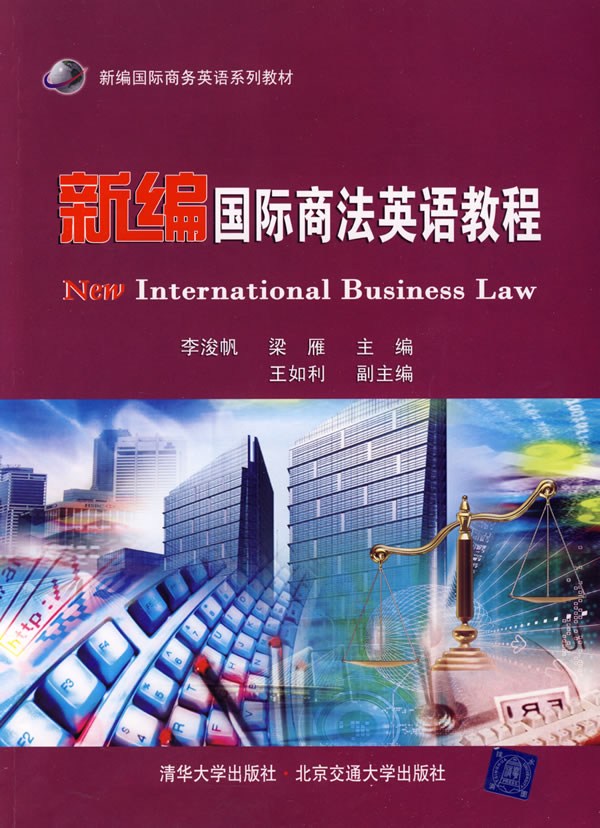
包邮新编国际商法英语教程-新编国际商务英语系列教材

- ISBN:9787811235487
- 装帧:暂无
- 册数:暂无
- 重量:暂无
- 开本:16开
- 页数:214
- 出版时间:2009-04-01
- 条形码:9787811235487 ; 978-7-81123-548-7
本书特色
《新编国际商法英语教程》为新编国际商务英语系列教材之一。
内容简介
本书共10章,涵盖国际商法导论、合同法、商事组织法、票据法、产品责任法、代理法、反倾销法与反补贴法、竞争法、知识产权法等内容,系统阐述了上述各个领域的重要国际条约、两大法系主要国家的重要法律规定,以及我国的相关法律法规。全书各章(除“国际商法导论”外)都附有相关的真实案件和判例,以帮助读者联系实际,加深理解。
本书既可以用作国际贸易等专业学生的国际商法教材和相关专业教师进行双语教学的参考书,还可以为国际商务及涉外法律等行业的人士提供帮助。
目录
1.1 国际商法概述
1.1.1 国际商法的定义
1.1.2 现代国际商法
1.1.3 国际商法的渊源
1.2 大陆法系
1.2.1 大陆法系简介
1.2.2 大陆法的特点
1.2.3 大陆法的渊源
1.3 普通法系
1.3.1 普通法系简介
1.3.2 普通法的特点
1.3.3 英国法的特点及渊源
1.3.4 美国法的特点及渊源
1.4 两大法系的比较
1.4.1 两大法系的区别
1.4.2 两大法系的新发展
1.5 与国际商法有关的国际组织
1.5.1 国际商会
1.5.2 国际法协会
1.5.3 联合国国际贸易法委员会
1.5.4 国际统一私法协会
1.6 国际商法与中国
chapter 2 合同法(一)
2.1 合同法概述
2.1.1 合同的定义及特征
2.1.2 合同的作用
2.1.3 各国合同法的简要介绍
2.2 合同的成立
2.2.1 要约与承诺
2.2.2 对价与约因
2.2.3 当事人的订约能力
2.2.4 合同的形式
2.2.5 合同的合法性
2.2.6 合意的真实性
2.3 合同的履行
……
chapter 3 合同法(二)
chapter 4 商事组织法
chapter 5 票据法
chapter 6 产品责任法
chapter 7 代理法
chapter 8 反倾销法与反补贴法
chapter 9 竞争法
chapter 10 其他与国际商务有关的法律
专业词汇表
参考文献
节选
《新编国际商法英语教程》共10章,涵盖国际商法导论、合同法、商事组织法、票据法、产品责任法、代理法、反倾销法与反补贴法、竞争法、知识产权法等内容,系统阐述了上述各个领域的重要国际条约、两大法系主要国家的重要法律规定,以及我国的相关法律法规。全书各章(除“国际商法导论”外)都附有相关的真实案件和判例,以帮助读者联系实际,加深理解。
《新编国际商法英语教程》既可以用作国际贸易等专业学生的国际商法教材和相关专业教师进行双语教学的参考书,还可以为国际商务及涉外法律等行业的人士提供帮助。
相关资料
插图:
1.3.3Characteristics and Sources of English Law英国法的特点及渊源
1. Characteristics of English law
English law is divided into common law and equity, which represents the primary characteristic of it.
The origins of the English common law lay in the justice of the king, exercised through his curiae,together with the customary law exercised in the old communal courts of shire and hundred, and thefeudal law exercised by the lord in relation to his own vassals. As overlord of all subjects, the king had aresidual right to give justice to all, and as feudal lord of the tenants-in-chief he had the right and theduty to sit in his curiae to hear their disputes. Until the time of Henry IT, royal justice was available tosubjects who were not tenants-in-chief only in exceptional cases~ However, in the reign of Henry II,access to the king's justice was extended by the enactment of a principle that "no man need answer for hisfreehold land without the king's writ being obtained". As these royal writs became popular with fitigants,they increasingly sought the justice of the king's courts rather than the local or feudal courts, whichslowly declined.
The king's justice was dispensed by the itinerant justices of the curiae. When the courts of CommonPleas, King's Bench, and Exchequer developed as separate entities, the law they applied was thecommon law. By the time of Edward I there was in existence a "common law" the law administered inthe king's courts throughout the land and therefore "common" to the whole kingdom.
As early as the 15'h century, people started petitioning the King for relief against unfair judgmentsand as the number of petitioners rapidly grew, the King delegated the task of hearing petitions to the LordChancellorv. The Chancellors were required to pass judgment guided by conscience and based on moralsand equality. It has been suggested that ecclesiastics were chosen for this position a
-

小妇人(纯英文)/床头灯英语.3000词读物
¥6.4¥15.8 -

英文滑稽诗300首:英汉对照
¥12.3¥42.0 -

名著名译英汉对照读本马克.吐温短篇小说选
¥10.5¥28.0 -

英语六级词汇背诵精典 高教版
¥19.9¥89.8 -

你往何处去
¥12.2¥33.0 -

MADAME BOVARY-包法利夫人
¥10.9¥36.8 -

浮生六记(汉英对照)
¥18.6¥65.0 -

柳林风声
¥10.9¥29.0 -

爱丽丝漫游奇境
¥3.1¥6.0 -

红与黑-纯英文版
¥6.7¥15.8 -

了不起的盖茨比(纯英文)/床头灯英语.3000词读物
¥5.5¥12.8 -

包法利夫人(英汉对照)
¥11.4¥29.8 -

三曹诗选英译
¥14.3¥38.0 -

小王子-法文朗读原版
¥7.8¥20.0 -

夜莺与玫瑰-全2册
¥12.3¥29.8 -

英诗选译-孙大雨译文集-(英汉对照)
¥13.2¥36.0 -

THE GREAT GATSBY-了不起的盖茨比
¥6.7¥16.8 -

威克菲尔德的牧师-(英语原著版.第三辑)
¥5.2¥12.0 -

新概念英语一课一练 1
¥13.2¥19.0 -

双语名著无障碍阅读名著丛书---纳尼亚传奇
¥16.7¥49.0













